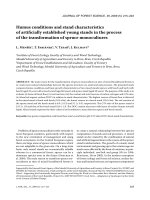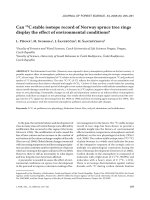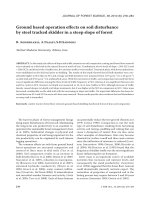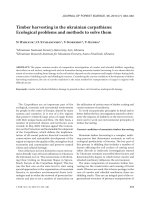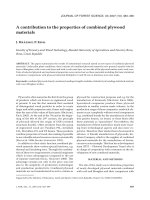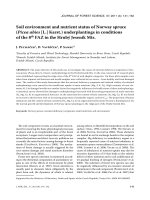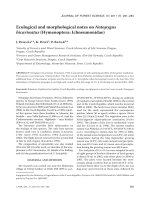Báo cáo lâm nghiệp: "Ecological conditions influencing the localization of egg-laying by females of the cockchafer (Melolontha hippocastani F.)" pps
Bạn đang xem bản rút gọn của tài liệu. Xem và tải ngay bản đầy đủ của tài liệu tại đây (285.04 KB, 9 trang )
16 J. FOR. SCI., 53, 2007 (Special Issue): 16–24
JOURNAL OF FOREST SCIENCE, 53, 2007 (Special Issue): 16–24
Ecological conditions influencing the localization
of egg-laying by females of the cockchafer
(Melolontha hippocastani F.)
M. Š
Forestry and Game Management Research Institute, Jíloviště-Strnady, Znojmo, Czech Republic
ABSTRACT: We explored the ecological conditions, which influence the female Melolontha hippocastani F. in their
selection of the locality for laying eggs. In the region of mass outbreak of M. hippocastani in the south-eastern part of
the Czech Republic in selected experimental sample plots including 1 to 8 year-old forest plantations we explored the
extent of losses caused by white grub feeding and the relation between the extent of the damage and the individual
characteristics of the experimental plots. e relation between the extent of the damage and the method of estab-
lishment of the stands and degree of weed infestation at the time of swarming was evaluated statistically. e daily
temperatures at the time of M. hippocastani swarming were recorded by means of automatic meteorological stations.
A light trap was used to monitor the course of swarming.
Keywords: forest protection; Melolontha hippocastani F.; white grub feeding; losses in forest plantations
In the regions of mass outbreak the Melolontha
hippocastani F. white grub feeding on roots causes
considerable damage to plants of forest tree spe-
cies, especially pine, oak, linden and others, some-
times destroying as much as 100%. e damage ap-
pears in 1 to 10 year-old forest plantations in the
period when the 2
nd
and 3
rd
white grub instars are
developing (Z 1956; Š, K
2004). In the Czech Republic at the present time M.
hippocastani has gradated on ca 10,000 ha of forest
soil and the area of destroyed forest plantations in
the individual years ranges from ca 50 to 300 ha
(Š 2006). at means that in the most seri-
ously affected regions forest regeneration has been
considerably hampered causing heavy economic
losses amounting to several million CZK. Defo-
liation caused by maturation feeding of beetles at
the beginning of the vegetation period is usually
not very serious for forest management. e only
exception is when they feed on young one or two-
year-old broadleaved plantings. On the other hand
Supported by the Ministry of Agriculture of the Czech Republic, Project No. MZe 0002070201.
white grub feeding in forest plantations followed
by dieback of tree causes serious damage to forest
management and may even restrict forest regen-
eration.
Possibilities of protection in the period of swarm-
ing of M. hippocastani adults are very limited be-
cause of environment protection in the localities,
which are part of protected areas (Natura 2000,
avian territory). e effectiveness of an interven-
tion using insecticides is also limited because of the
long period of swarming (several weeks); it is dif-
ficult to reduce the cockchafer population with one
single application of effective chemical insecticide.
e bio-preparations tested so far have usually not
achieved the required results.
Using a soil insecticide, which is usually applied
to the roots at the time of planting, appears to be
a promising measure against the white grub. With
this method of protection accurate prognosis when
selecting the endangered localities is very impor-
tant; the application of the soil insecticide must be
J. FOR. SCI., 53, 2007 (Special Issue): 16–24 17
targeted and sufficiently effective and economical.
It is therefore important to obtain as much infor-
mation as possible about the circumstances and ef-
fects, which influence the M. hippocastani female
when selecting a locality to lay eggs.
Forest regeneration is affected by white grub,
which develops in forest plantations younger than
ca 10 years, namely in one to two-year-old stands.
Most endangered are plantations established two
years before the main swarming period; that means
at the time when the newly planted plants are ex-
posed to feeding of white grub of the 2
nd
and 3
rd
instars in two vegetation periods. Feeding of white
grub developing in older stands does not cause tree
dieback. In terms of forest protection it is there-
fore important to explore, which climate, ecologi-
cal and economic effects may affect egg-laying of
the females in the endangered localities, or which
economic measures would discourage the females
to lay eggs in the young forest plantations, or re-
duce it.
e objective of the study and the studied region
e objective of the study was to evaluate the
extent of damage caused by white grub feeding in
a selected set of sample plots with forest planta-
tions aged 1 to 8 years in the period until the next
swarming; basing on the correlation between the
extent of the damage and the individual character-
istics of the sample plots to deduce, which factors
influenced the M. hippocastani females in their se-
lection of the locality for laying the eggs.
Experimental investigations were conducted in
the Vracov locality (coordinates 54°29', 36°62') in
the Forest District Strážnice, altitude 193 m. In
this district 62.7 ha of young forest stands were
destroyed by white grub in 1999–2002 during the
M. hippocastani
developmental cycle; in the fol-
lowing developmental cycle in 2003–2006 it was
86.5 ha. e Vracov locality lies in south-east Mora-
via where the long-term average air temperature is
9.3°C and the annual sum of precipitation ranges
around 450 mm. It is one of the warmest regions
in the Czech Republic. A strong tribe of M. hippoc-
astani with a 4-year developmental cycle is located
in the Vracov locality. e last two heavy swarms
appeared in 2003 (Š 2006) and in 2007.
MATERIAL AND METHODS
A light trap with a HQL 125 W discharge lamp
was used to control the swarming. e numbers of
trapped cockchafers and the sex ratio were record-
ed on individual days. e insects swarmed from
20 April to 2 June 2003.
In 2003, at the time of mass swarming of M. hip-
pocastani in the Vracov locality, we recorded and
evaluated the daily maximal, minimal and average
temperatures using an automatic meteorological
station of the 431 B type.
Research activities were launched in 2004, one
year after mass swarming of the M. hippocastani
adults. In the first stage we selected 30 sample
plots, i.e. forest plantations, and in the two follow-
ing years we monitored the course and extent of
damage on plants caused by cockchafer feeding. In
the individual sample plots we recorded the age of
the plants, tree species, method of establishment
(full-area preparation, ploughing, repair planting),
presence of broadleaved species in the neighbour-
hood, degree of weed infestation at the time of
swarming and the final extent of plant losses after
the end of white grub development in the second
half of 2006 (Table 1).
e plantation in the region was established us-
ing two methods; full-area soil preparation and
ploughing of the forested area. Full-area preparation
consisted of pulling out the stumps, part of which
were placed into a prepared hole and covered with
earth and part was heaped into a mound across the
forested area. e whole area was ploughed and
evened out so that the tree plants were planted out
in an area completely free of weeds. Using the other
method, i.e. ploughing, the stumps remained on the
forested area and furrows were ploughed across the
area, 1.4 m spacing. e plants of the woody spe-
cies were planted into the ploughed up furrows; the
original weeds between the rows were preserved
and they very quickly grew back into the furrows.
To a lesser extent the plantation was established
using repair planting in places where white grub
feeding had destroyed the plants; subsequently the
open places were planted out. In recent years we
see efforts to apply natural seeding, i.e. of plants,
which grow from seeds carried over to the open
space from the neighbouring stands.
e correlation between the extent of the dam-
age and method of plantation establishment and
degree of weed infestation at the time of swarming
was evaluated statistically using variance analysis
(ANOVA). Considering that the values of the in-
dividual degrees of factors were very unbalanced
and no normality and homoscedasticity of the in-
dividual sets was proved (tested by Shapiro-Wilks
normality test and Bartlett test of homoscedastic-
ity), we used the non-parametric Kruskal-Wallis
test and subsequent test of multiple comparisons
18 J. FOR. SCI., 53, 2007 (Special Issue): 16–24
Table 1. Survey of sample plots
Stand No.
Area
(ha)
Age
2003
Tree
species
Losses-reduced
area (%)
Method of establishment Broadleaves in neighbourhood
Spraying
2003
Weed infestation
2003 (%)
220A12 0.9 2 Pinus 100 ploughing from all sides – B,C,Q,F yes 100
220A0 1.5 2 Pinus 100 ploughing from all sides – F,Q,T,B yes 100
260D12 2 1 to 7 Pinus 40 ploughing none no 70
261A11 1.2 1 Pinus, Betula 20 full-area prep. from one side Robinia no 20
262B12 1.5 1 to 8 Pinus 20 repair planting from one side – Q,B,F,R yes 70
263A10-1 1.7 4 Pinus 0 full-area prep. from one side – F,Q yes 0
263A10-2 1.7 4 Pinus 80 ploughing from one side – Q,C,F yes 100
256C10-1 2 7 Pinus 60 ploughing from one side – Q,C,F yes 100
256C10-2 2 8 Pinus 5 full-area prep. form one side – F,T,C yes 0
256B10 2 8 Pinus 0 full-area prep. none no 0
247A1 0.3 1 to 4 Pinus 10 repair planting from one side – Q,A no 0
248A11 0.9 3 Pinus 0 full-area prep. none no 0
247A11 1.3 2 Pinus 60 ploughing none no 100
247C10 2 1 Pinus 50 ploughing none no 100
249B9 1 3 Pinus 0 full-area prep. none no 0
249E 1 3 Pinus 0 full-area prep. none no 0
248B10 1.4 6 Pinus, Tilia 30 repair planting none no 30
248C10 1.4 1 Pinus 90 ploughing none no 100
248A11 1.5 8 Pinus 0 full-area prep. none no 0
252D10 1.3 5 Pinus 0 full-area prep. from two sides Quercus no 0
252C10 1.8 4 Pinus, Tilia 5 full-area prep. Robinia in undergrowth no 0
252B10 1.6 4 Pinus, Tilia 5 full-area prep. Robinia in undergrowth no 0
253B10 1.3 4 Pinus, Tilia 20 ploughing Robinia in undergrowth yes 50
224C11 3 4 Pinus 40 ploughing Robinia in undergrowth yes 100
223D11-1 2 9 Pinus 10 ploughing none yes 100
216C10 0.7 3 Tilia, Pinus 10 ploughing none yes 100
223D11-2 1.8 7 Pinus 0 natural seeding from one side – Q,B yes 0
220B11 1 2 Pinus 5 ploughing none no 50
249A11 0.4 2 Pinus 30 ploughing none no 100
223C1 0.8 10 Pinus 40 ploughing none no 80
Q – Quercus, B – Betula, F – Fagus, R – Robinia, C – Carpinus, T – Tilia, A – Alnus
J. FOR. SCI., 53, 2007 (Special Issue): 16–24 19
by means of the Statistica 7.0 statistical programme
(StatSoft, Inc. 2006).
RESULTS AND DISCUSSION
From the results of controls of cockchafer
swarming in 2003 (Fig. 1) it follows that the bee-
tles emerged from 16 April to 2 June when 19,510
cockchafers were trapped in the light trap, of which
12,054 were males and 7,456 females. Heavy in-
tensive swarming was seen between 28 April and
12 May when 18,062 cockchafers were trapped, i.e.
92.58% of the total number of the entire period of
swarming; in this time interval intensive egg laying
into the soil could be assumed.
Basing on records of daily temperatures meas-
ured using the automatic meteorological station
(Fig. 2) the average temperature in May 2003 was
17.4°C and during the 15 days of intensive peak
swarming from 28 April to 12 May it was 18.2°C;
in 4 days of this period the maximal temperature
exceeded 30°C.
When we compare the temperatures in the Vra-
cov locality in May 2003 with the 10-year average
May temperature (Table 2 – data of the Hydrome-
teorological Institute, Strážnice, 176 m a.s.l.) it is
obvious that the average temperature in May 2003
was by 2.3°C higher than the 10-year average. Dur-
ing the 5 days from 6 to 10 May 2003, i.e. in the
period of the absolute peak of swarming, when the
females probably laid eggs, tropical weather pre-
vailed and the average temperature was 21°C, i.e.
6.6°C above the 10-year average.
Basing on evaluations of the extent of damage on
plants depending on their age we see that the one
and two-year old plantations were damaged most
frequently and most extensively, although the dam-
age was not negligible in older plantations as much
as 10 years old either. If we take the individual spe-
cies then damaged was almost exclusively pine and
is due to the fact that the proportion of pine in re-
forestation in the region is ca 90%.
e effect of the method of establishment of the
plantation on the damage of plants showed a sta-
tistically significant difference between losses in
full-area prepared areas and ploughed areas, in fa-
vour of full-area preparation where 0 to 20% of the
plants were damaged, but mostly not exceeding 5%.
After ploughing the plant losses reached 0 to 100%;
on the larger part of the area the losses exceeded
50% (Fig. 3). We did not have enough data to carry
out statistical evaluations of the losses after repair
planting and natural seeding.
Weed infestation is also closely connected with
the method of plantation establishment. A sta-
tistically significant difference was observed be-
tween the zero and 100% degree of weed infesta-
tion, whereas for evaluations of the medium level
of weed infestation these data were too variable
(Fig. 4).
Broadleaved trees in the neighbourhood of the
sample plots were sources of maturation feeding of
the beetles and a place where they gathered. It is a
factor, which contributes to the selection of plac-
es in the neighbourhood for laying eggs; however
from our present evaluations we cannot determine
20.ȱ4.
24.ȱ4.
28.ȱ4.ȱ
2.ȱ5.ȱ
6.ȱ5.ȱ
10.ȱ5.ȱ
14.ȱ5.ȱ
18.ȱ5.ȱ
22.ȱ5.ȱ
26.ȱ5.ȱ
30.ȱ5.ȱ
3.ȱ6.ȱ
S1
0
500
1,000
1,500
2,000
2,500
3,000
3,500
Numberȱofȱbeetles
Fig. 1. Swarming of Melolontha
hippocastani F. in 2003 in the
Vracov locality
Date of control of light trap
20 J. FOR. SCI., 53, 2007 (Special Issue): 16–24
a definite dependence. Likewise data on the effect
of aerial interventions in 2003 on an area of 508 ha
against the beetles at the time of swarming were
not evincible.
In 2003 when the M. hippocastani females laid
their eggs the temperatures were above-average. We
must take this fact into account when we assess the
loss of plants in the respective sample plots and when
we define the correlation between the extent of the
damage and the individual ecological characteristics.
It would be worthwhile to compare these findings
with data obtained in the following developmental
period of M. hippocastani, i.e. under different mete-
orological conditions, to be able to specify the effect
of the individual ecological factors.
K et al. (1953) summarized informa-
tion and data on the egg-laying of female cock-
chafers. How deeply they lay the eggs depends on
the looseness and type of soil. e eggs are most
frequently laid in clusters of 10 to 36 eggs in a depth
of ca 10 to 30 cm. F et al. (1954) reported
that the eggs are laid in small piles of not more than
20 eggs. After the eggs are laid the females crawl
out to the surface and return to the second matura-
tion feeding and when it is finished they lay eggs
again. Some females fly to their third maturation
feeding and then lay eggs for the third time. Under
the same conditions Melolontha melolontha L. fe-
males lay the eggs deeper in the soil than those of
M. hippocastani. e development of the eggs from
the time of their laying until the larvae hatch de-
pends on the temperature and humidity of the soil
and usually lasts 40 to 50 days. e development of
white grub is dependent on the climate conditions
Table 2. Average temperatures in May in 1997 to 2006 – Strážnice
Year
Days
1–5 6–10 11–15 16–20 21–25 26–31 1–31
1997 15.1 13.1 20.4 21.2 13.7 10.9 15.6
1998 12.7 17.4 17.4 13.9 12.3 19.6 15.7
1999 14.2 13.7 14.0 13.3 16.1 22.0 15.7
2000 14.7 17.6 15.8 14.9 14.2 16.4 15.6
2001 18.2 13.3 13.5 14.7 14.1 17.0 15.2
2002 19.7 16.4 16.5 17.5 18.5 15.7 17.3
2003 15.0 19.6 13.5 14.8 14.8 19.6 16.3
2004 16.5 10.9 11.2 11.9 10.0 12.9 12.3
2005 15.7 8.3 11.0 11.4 15.1 19.6 13.5
2006 11.8 14.1 14.3 16.5 16.2 12.3 14.1
Average 15.4 14.4 14.8 15.0 14.5 16.6 15.1
0
5
10
15
20
25
30
35
20.ȱ4.
24.ȱ
4.
ȱ
28.
ȱ
4.
ȱ
2.
ȱ
5.ȱ
6.
ȱ
5.ȱ
10.ȱ5.
ȱ
14.ȱ5.
ȱ
18.
ȱ5.
ȱ
22.ȱ5.
ȱ
26.ȱ5.
ȱ
30.
ȱ5.
ȱ
3.
ȱ
6.
ȱ
Date
Temperatureȱ(°C)
minimum average maximum
Fig. 2. Daily temperatures at the
time of Melontha hippocastani F.
swarming in 2003 in the Vracov
locality
J. FOR. SCI., 53, 2007 (Special Issue): 16–24 21
of the region; in nature the cycle of cockchafer gen-
erations takes 3 to 5 years. Only M. hippocastani
are known to have a 5-year cycle, i.e. in the more
northern regions. In the 3-year developmental cy-
cle the first moulting takes place as soon as in the
year of hatching and already in the advanced sec-
ond stage the larvae winter. In the 4-year develop-
mental cycle the first moulting of larvae does not
occur until after wintering, i.e. in June to July of the
second year of their development. e length of the
developmental cycle is affected particularly by the
temperature during the 1
st
and 2
nd
larval stage. In
the soil the white grub moves horizontally when
searching for food and the depth depends on the
Fig. 3. Comparison of losses in terms of soil preparation
(N – ploughing, C – whole-area preparation, V – improvement) (H is the test criterion) P = 0.001
Code Number of valid Sum of sequences
N 101 16 344.500
C 102 11 72.500
V 103 3 48.000
Kruskal-Wallis test: H (2, N = 30) =19.14298, P = 0.0001
Preparation; MNC means
Current effect: F (2, 27) = 11.593, P = 0.00023
Decompositon of effective hypothesis
Vertical columns indicate 0.95 intervals of reliability
Ploughing Whole-area preparation Improvement
Type of preparation
e hypothesis that the effect of soil preparation on losses during forestation has no effect was rejected.
N R: 21.531 C R: 6.5909 V R: 16.000
N 0.000044 0.952883
C 0.000044 0.302437
V 0.953883 0.302437
Test of multiple comparisons: as shown in the graph, the difference between ploughing and whole-area
preparation is significant.
70
60
50
40
30
20
10
0
–10
–20
Losses (%)
22 J. FOR. SCI., 53, 2007 (Special Issue): 16–24
soil humidity and temperature; if the soil is dry and
cold the white grub hide deeper in the soil. e
usual depth for wintering is 30 to 60 cm, sometimes
even 150 cm; during feeding the white grub move
in a depth of 5 to 20 cm. Horizontal movement in
search for food depends on the temperature and
type of soil. During their development the white
grub may move to an average distance of 70 to
150 cm, maximally to a distance of 3 to 4.5 m. e
most serious damage is caused by white grub of
the 2
nd
and namely 3
rd
stage feeding roots ca 5 mm
deep and gnawing the stronger roots. White grub
is largely omnivorous, but in our experience it is
obvious that in the felled areas it prefers roots of
plants, particularly pine, oak, linden and in forest
nurseries also spruce plants. White grub does not
attack willow, poplar or alder. A full-grown white
grub of the 3
rd
stage pupates in July to August in a
depth of 30 to 40 cm or even more.
Opinions on how the female M. hippocastani
choose the place for laying the eggs differ. For in-
stance F et al. (1954) discovered that females
prefer places shaded by tree crowns, but they avoid
over-shading and so they do not fly into very dense
stands. On the other hand, in colder northern loca-
tions they find optimal conditions for development
Fig. 4. Comparison of losses in terms of the rate of weed infestation
Code Number of valid Sum of sequences
0 11 69.500
20 1 16.000
30 1 19.000
50 3 44.500
70 2 38.000
80 1 22.000
100 11 256.000
Kruskal-Wallis test: H (6, N = 30) = 21.99181, P = 0.0012
Forest weeds; MNC means
Current effect: F (6, 23) = 5.7547, P = 0.00089
Decompositon of effective hypothesis
Vertical columns indicate 0.95 intervals of reliability
0 20 30 50 70 80 100
Forest weeds (%)
e hypothesis that weed infestation has no effect on losses was rejected.
Due to the great variability of the data only the significant difference between zero and full weed
infestation can be confirmed.
100
80
60
40
20
0
–20
–40
Losses (%)
J. FOR. SCI., 53, 2007 (Special Issue): 16–24 23
on open areas without trees, in forest glades and
clearings. However in all the areas the cockchafer
finds optimal conditions in pine saplings where it
concentrates. On the other hand Z (1956)
reported that M. hippocastani appeared mostly in
open broken oak forests and free-growing broad-
leaved young growth and that they damaged the
invaded trees usually over the entire space of open
stands. Irregular infestation of forest plantations is
influenced by the uneven distance of the forested
area from the feeding places of the cockchafers as
well as the soil properties and different micro-cli-
mate conditions. e female’s choice of the place
for laying the eggs is based on the micro-climate
conditions and soil properties. ey avoid places
shaded by the surrounding stand and by individual
trees. ey seek out weed-free places in forest tree
nurseries and in loosened soil.
According to F et al. (1954) in the more
southern localities on light sandy soils the M. hip-
pocastani female lays eggs in relatively dense stands
and in heavy soil in more open stands. In the more
northern localities they gradually choose more
open localities, for instance forested clearings, and
in the northernmost part of their distribution they
lay eggs in open sun-warmed clearings.
e general findings of F et al. (1954) and
Z (1956) that the choice of the locality for
the laying of eggs is influenced by the momentary
temperature were confirmed. Under high tem-
peratures the females choose areas shaded by tree
crowns or weeds and in cold weather they prefer
more open localities. Depending on the tempera-
ture at the time of egg-laying the females look for
localities, which provide optimal conditions for the
development of the new population; these places
may be variously thick stands and clearings with
plants of various ages and with a different level of
weed infestation. e degree of white grub infesta-
tion of forest plantations is also dependent on the
distance from the cockchafers’ feeding places and
on soil and microclimate conditions.
CONCLUSION
In the locality there is one cockchafer tribe,
which does not form sub-populations in the years
between the main swarmings and in the individual
years the damage is caused by white grub of the
same instar.
In the period of peak swarming in the emergence
year 2003 and when the M. hippocastani females
laid eggs, it was very warm in the Vracov locality
with above-average temperatures.
Results of control of the damaged plants con-
firmed that plant losses on the areas forested af-
ter full-area preparation with no weeds at the time
of swarming were considerably lower than on the
ploughed areas heavily weeded between the rows.
e results of statistical evaluations confirmed
that when choosing the place to lay their eggs the
females preferred localities shaded by the forest
stand or at least by weeds.
e effect of broadleaved trees as a source of food
during maturation feeding of adults on the amount
of damaged plants in the neighbouring plantations
was not positively confirmed.
Likewise the effect of aerial preventive interven-
tion against the beetles conducted in 2003 on the
amount of damages plants was not demonstrable.
Comparisons of the population density in 2003 and
2007 will be able on the basis of results of the con-
trol of swarming in the light trap in both years.
In terms of preventive protection against plant
losses caused by white grub it appears that appropri-
ate is full-area soil preparation. However, the results
achieved in 2003–2006 must be correlated with con-
crete meteorological conditions at the time of egg-
laying in 2003 and compared with results of similar
investigations conducted in the period 2007–2010.
We can wrap-up by saying that the degree of
damage of the plantation depends on the num-
bers of white grub and on the age and spacing of
the plants. e larger the number of high-quality
plants with a well developed root system is used
for reforestation, the more likely is successful re-
generation. e tree species, e.g. pine, are capable
of regeneration after the root system is damaged.
New roots grow above the damaged part, which
can substitute the destroyed roots. Regeneration of
the damaged roots is dependent on the degree of
damage and on soil humidity. However, with mass
outbreak of white grub we see that also grown up
plants succumb, or if the root system is damaged
seriously they die in the following year.
Successful regeneration is also influenced by cor-
rect technology of planting and by the site condi-
tions, as they considerably affect the regeneration
ability of the plants.
Refere nc es
FLEROV S.K., PONOMAREVOVÁ E.N., KLJUŠNÍK P.I., VO-
RONCOV A.I., 1954. Ochrana lesů. Praha, SZN: 352.
KRATOCHVÍL J., LANDA V., NOVÁK K., SKUHRAVÝ V., 1953.
Chrousti a boj s nimi. Praha, Nakladatelství ČSAV: 156.
ŠVESTKA M., 2006. Distribution of tribes of cockchafers of
the genus Melolontha in forests of the Czech Republic and
24 J. FOR. SCI., 53, 2007 (Special Issue): 16–24
the dependence of their swarming on temperature. Journal
of Forest Science, 52: 520–530.
ŠVESTKA M., KAPITOLA P., 2004. Přemnožení chroustů
v lesích ČR a obrana proti nim. In: Sborník ze semináře
Škodliví činitelé v lesích Česka 2003/2004, Praha, 31. 3.
2004. Jíloviště-Strnady, VÚLHM: 52–57.
ZÁRUBA C., 1956. Ponravy, škůdci lesních školek a kultur.
Praha, SZN: 48.
StatSoft, Inc., 2006. Statistica 7 – User Manual. Tulsa, USA.
Ekologické podmínky ovlivňující lokalizaci kladení vajíček samičkami
chrousta maďalového Melolontha hippocastani F.
ABSTRAKT: Byly studovány ekologické podmínky ovlivňující samice Melolontha hippocastani F. při výběru loka-
lity pro kladení vajíček. V oblasti kalamitního přemnožení
M. hippocastani na jihovýchodě České republiky byl ve
vybraném souboru zkusných ploch, zahrnujícím lesní kultury ve věku jednoho až osmi let, hodnocen rozsah ztrát
způsobených žírem ponrav a posuzován vztah mezi rozsahem ztrát a jednotlivými charakteristikami pokusných
ploch. Vztah mezi rozsahem ztrát a způsobem založení kultury a stupněm zabuřenění v době rojení byl vyhodnocen
statisticky. Denní teploty v období rojení
M. hippocastani byly zaznamenány pomocí automatické meteostanice.
Průběh rojení byl kontrolován světelným lapačem.
Klíčová slova: ochrana lesa; Melolontha hippocastani F.; žír ponrav; ztráty v lesních kulturách
Corresponding author:
Ing. M Š, DrSc., Výzkumný ústav lesního hospodářství a myslivosti, v.v.i., Jíloviště-Strnady,
pracoviště Znojmo, Dvořákova 21, 669 02 Znojmo, Česká republika
tel./fax: + 420 515 222 483, e-mail:



